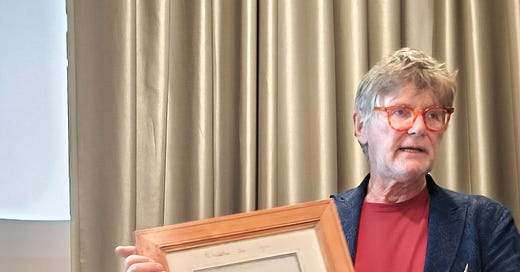Zufall, Ataraxia, and the Art of Systematic Positioning
From Vienna’s camera relics to the financial reset of 2025
Two weeks ago, thanks to our local Lions Club Elias Holl, I had the rare pleasure of attending a talk by Peter Coeln, the pioneering Austrian gallerist, photography collector, and founder of Vienna’s WestLicht and OstLicht museums. With a disarming mix of Austrian charm and directness, Peter recounted his improbable journey—from being one of the first to open a Leica store, to acquiring and preserving some of the rarest photographic artifacts on Earth.
One object in particular stood out: a Daguerreotype camera from 1839, widely recognized as the world’s first commercially produced camera. It once sold for €580,000 and now resides in WestLicht.
Peter attributed much of his success to Zufall—chance. In his words, nearly everything in his career was coincidence. Yet, listening to his stories, it became increasingly clear that this wasn’t just luck. It was deliberate curiosity, paired with a calm, risk-embracing temperament. He wasn’t just reacting to opportunity—he was constantly placing himself in high-upside optionality with a clear, grounded state of mind.
This struck me immediately as something deeper than luck. It reminded me of an ancient Greek concept I’ve always found useful—particularly in trading:
What Is Ataraxia?
Ataraxia (ἀταραξία) is an ancient term from Hellenistic philosophy—especially Epicureanism, Stoicism, and Skepticism—meaning a lucid state of tranquility; freedom from mental disturbance or anxiety.
Unlike Stoic apatheia, which often feels more like cold detachment, ataraxia is the art of calm engagement. It’s not about withdrawal or inaction—it’s about acting from a place of inner stillness and clarity, no matter how volatile the world becomes.
In finance, this is rare.
Behavioral Finance vs. Ataraxia
Most investors—and let’s be honest, most of us—do the opposite. Instead of ataraxia, we often fall into:
Noise-chasing: Acting on the latest headline or macro “hot take.”
Overtrading: Mistaking activity for control or insight.
Loss aversion panic: Reacting emotionally to drawdowns and exiting at the worst time.
Recency bias: Assuming recent events are the new permanent regime.
These are the behaviors that erode returns and clarity. They aren’t just errors in logic—they’re failures of composure. Failures of ataraxia.
Framing Reality: Between Cameras and Engines
Peter Coeln’s work in photography reminded me how much power lies in framing—choosing your lens, setting up the shot, and then letting the moment unfold. In photography, you don’t control the light or the movement, but you create the conditions to capture meaning when it appears.
That mindset carries over into systematic trading. We don’t respond to every flicker in the market—we build a model, define the parameters, and trust it to respond systematically when the time is right. It’s not about constant decision-making. It’s about structuring a process in advance, then letting go.
This is where I’d like to briefly contrast another perspective—from Donald MacKenzie’s An Engine, Not a Camera. In that book, MacKenzie argues that financial models don’t merely observe the market (like cameras); they shape it. They are engines that influence behavior, pricing, and structure. It’s a valuable insight, especially when thinking about how dominant models can reinforce certain dynamics.
But the metaphor I’m exploring here is the opposite: not how models shape the market, but how we shape our readiness for whatever the market delivers. The camera, in this case, isn’t about market influence—it’s about mental clarity, about setting up a process that lets us act without overreacting. That’s ataraxia in practice: positioning with intention, then stepping back and allowing the picture to form.
Systematic Trend Following and the Calm Reset
At Takahē Capital, we’re preparing to launch our Global Markets Fund on May 1st, 2025. The timing couldn’t be more interesting.
Systematic trend strategies, especially the more volatile variants like ours, have recently faced a bumpy period. The SG Trend Index is down -5.85% month-to-date, and dispersion among trend followers has been wide. Some programs have likely faced steep drawdowns.
But here’s the thing: this is the kind of environment where clean slates emerge.
In our models, trends are reasserting themselves in places like gold, energy shorts, and FX (we’ve gone long EUR and CHF, short USD). We’ve even taken directional equity exposures—short NASDAQ and Euro Stoxx 50—though we continue to view equities as fragmented.
As I said in a recent interview with EQD:
“Systematic trend doesn’t predict—it adapts. It may lag at the turn, but it thrives in persistence. Moments like these, post-drawdown, mid-reset, are classic inflection points—not because the future is certain, but because positioning begins with a clean slate.”
To maintain that discipline requires something very close to ataraxia: the ability to act systematically, even as others react impulsively.
Peter Coeln’s Lesson for Traders
So what’s the link between a photography collector in Vienna and a quant fund launching into market uncertainty?
It’s this: Peter Coeln’s success may seem accidental, but it was shaped by consistent exposure to optionality, guided by calm judgment and genuine curiosity. He didn’t force outcomes—he created conditions for them. And he did so without panic, noise, or overconfidence.
That’s the heart of ataraxia: not trying to control randomness, but remaining undisturbed by it.
As we move into this next phase of the market, that mindset might be more valuable than any algorithm.
A Note to Readers
If you’re ever in Vienna, I highly recommend visiting WestLicht or OstLicht. They are more than museums—they are temples to curiosity, craftsmanship, and the long arc of time. Much like markets, really.
And if you’re an accredited investor looking for exposure to high-volatility, systematically-driven trend following, feel free to reach out to us at contact@takahe.capital. The launch is coming soon, and we’re excited to welcome like-minded partners.
Stay curious. Stay calm. Stay positioned.





Why Sytematic TF is hard to do yet profitable....“Systematic trend doesn’t predict—it adapts. It may lag at the turn, but it thrives in persistence..." GREAT QUOTE.
at ara Ziya @Alan Dershowitz